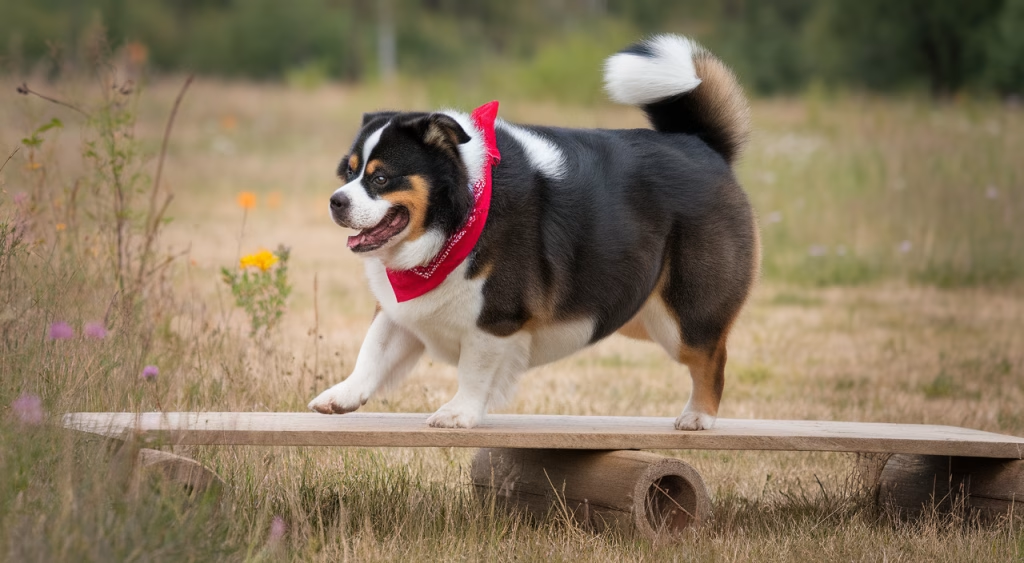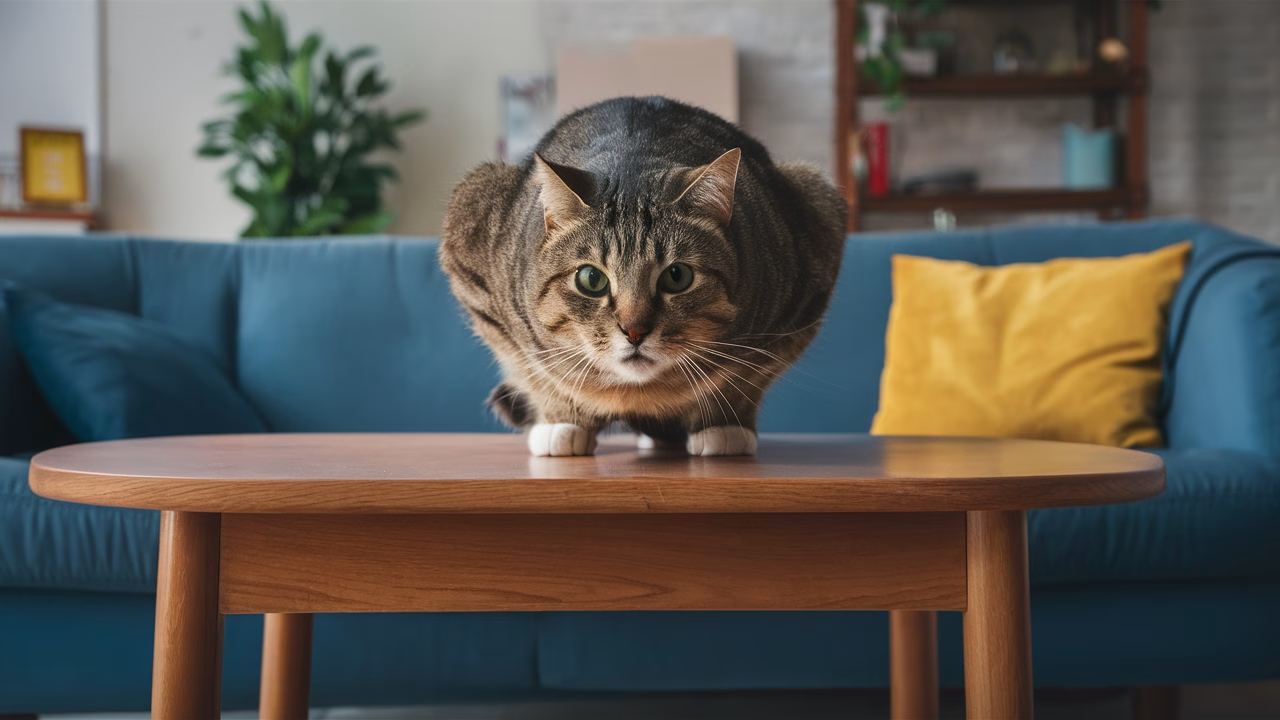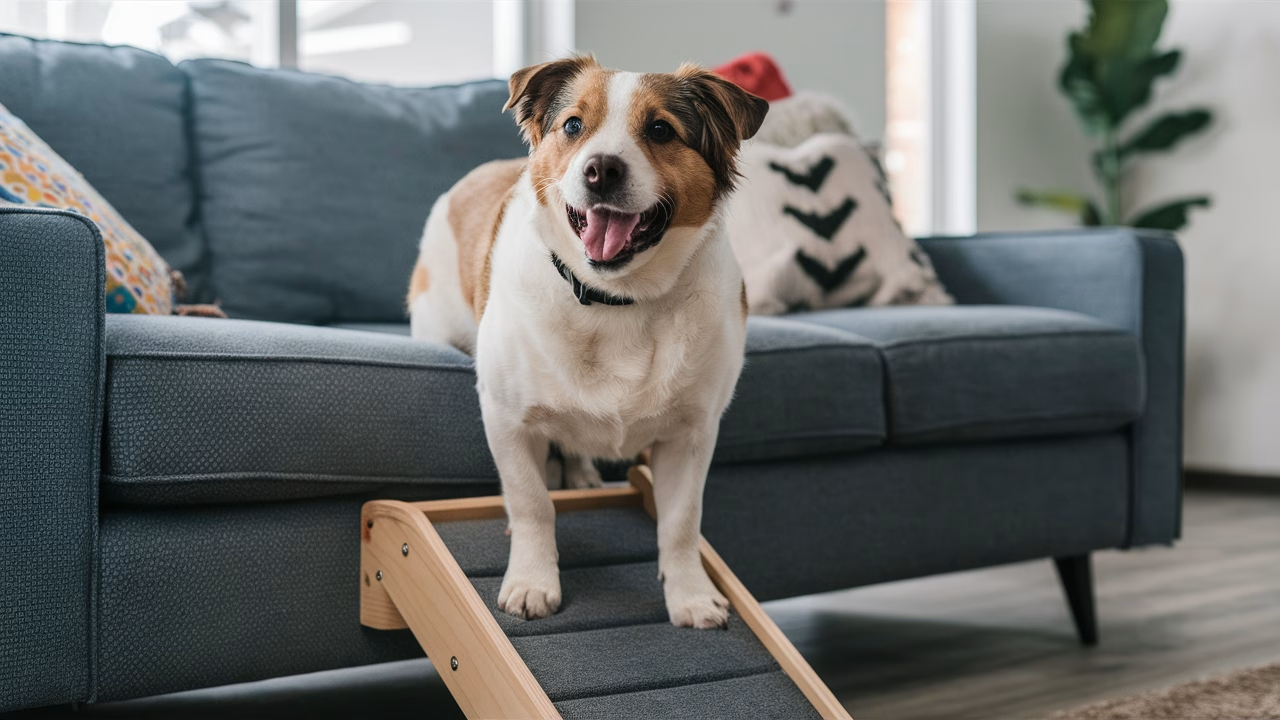Why Do Overweight Pets Still Think They’re Athletes?
Because of something called the athletic identity disconnect—a fascinating (and hilarious) phenomenon where pets retain the instincts and confidence of their youthful, spry selves despite any recent…chunk accumulation.
- Pets don’t recognize their weight gain the way humans do. Their sense of self comes from instinct, not reflection.
- Over 60% of cats and dogs in America are overweight. But they still climb, leap, and zoom like it’s puppy/kittenhood.
- Their self-belief can lead to accidental injuries. But it also shows how wonderfully optimistic animals are.
- Solutions like pet stairs and ramps can help your pet reach their favorite spots without taking flight risks.
- You don’t need to stop the play—just make it safer. We’ll show you how to preserve their zest while protecting their joints.
Understanding the Athletic Identity Disconnect
Ever seen a chunky cat perched like a ninja atop a wobbly bookshelf, gazing toward the fridge as if ready to channel its inner jungle panther? That glorious moment of delusion is textbook athletic identity disconnect. This behavioral quirk refers to the mismatch between an animal’s internal self-image and their actual, physical limitations.
Unlike us humans, pets don’t reevaluate themselves in mirrors. There are no existential crises in a Labrador’s life over an expanding waistline. Instead, pets rely on muscle memory and instinct. If Sparky cleared the backyard fence in a single bound last summer, then by golly he’ll try again—despite that new sausage-like physique.
This contributes to what researchers call overweight pets retaining athletic confidence. And yes, it’s both adorable and dangerous. Pets, unaware of injuries looming like cartoon anvils, miscalculate jumps or attempt feats better suited to leaner days. But science isn’t laughing—veterinary behaviorists take this very seriously, studying how animal cognition influences these consistent misjudgments in our beloved companions.
The athletic identity disconnect is most prominent in formerly athletic domesticated animals. Think a greyhound who still zoomies despite gaining 15 lbs, or the Border Collie that believes stairs are a racetrack no matter the vet’s warnings. These playful behaviors persist because your pet’s brain hasn’t updated its body awareness software.
Signs of Athletic Identity Disconnect
| Behavior | Interpretation |
|---|---|
| Attempting difficult jumps | Muscle memory at odds with current body |
| Surprised face after failed leap | No recalculation after a failure |
| Repeated failed actions | Lack of visual self-awareness |
| Zoomies despite big belly | Instinctive play not limited by size |
| Confused by broken perches | Denial of added weight |
Hilarious Behaviors of Overweight Pets
There’s a reason “chunky cat fails” rack up millions of views online. These moments aren’t just entertaining—they represent blissfully confident animals executing their default programming with delight, if not grace. Let’s explore the drama of pets versus physics and see how animal cognition creates these laugh-out-loud moments.
- Chester, the 20-lb tabby became an internet icon when he flopped mid-jump between the coffee table and couch—his body made the attempt, gravity made the decision.
- Magnus the eagle at a wildlife rehab center kept snapping tree branches like toothpicks, mystified each time by physics. Hint: he’d gained 30% weight post-injury.
- Boulder the 400-lb seal launched himself with Olympic verve onto narrow trainer platforms designed for leaner pinnipeds. He failed—a lot. But never stopped trying!
- Parrots landing on flimsy perches, breaking them, then looking offended at the universe for changing the rules.
Animals don’t internalize failure the way we do. Their attitude? “Hmm weird branch. Guess I’ll try again in five minutes.” This optimistic persistence is part of what makes their playful behaviors so endearing—and why we need to help them stay safe.
How to Help Overweight Pets Exercise Safely
Now, let’s talk turkey—or maybe kibble. Behind the laughs lies a genuine risk: injuries from mismatched ability and ambition. When the athletic identity disconnect leads a pudgy pug to leap from a couch like he’s Parkour-trained, sprains and bruises aren’t far behind. That’s where you come in—with thoughtful, proactive support and a plan to help your beloved companion stay active without getting hurt.
They’ll keep trying. So let’s make it safe. Learning how to help overweight pets exercise safely becomes crucial when you’re dealing with a pet who thinks they’re still an Olympic athlete.
Do’s and Don’ts
| Do | Don’t |
|---|---|
| Use pet stairs for beds/couches | Let pets jump onto high surfaces alone |
| Install ramps for mobility | React with laughter only to failed jumps |
| Encourage gentle play/exercise | Push heavy pets into intense activity |
| Track weight & energy daily | Assume animals self-regulate weight |
| Work with a vet to create a plan | Crash diet or restrict food drastically |
Fun Ways to Keep Chunky Cats Active
The best part about animals? Their endless adaptability. They’ll keep trying, and we can help them succeed. Understanding how to help overweight pets exercise safely means working with their natural instincts, not against them.
Creative Exercise Solutions for Cats
- Play interactively with feather wands and dangling toys to inspire soft jumping that builds muscle gradually.
- Use puzzle feeders to stimulate animal cognition and slow ingestion while encouraging movement.
- Vertical options like staggered steps or towers—with manageable spacing—cater to climbing needs safely.
- Laser pointer sessions get chunky cats moving without high-impact jumps.
- Treat-dispensing balls combine mental stimulation with gentle physical activity.
Safe Exercise Ideas for Dogs
- Leash walks with frequent sniff breaks support mobility without overexertion while honoring their natural playful behaviors.
- Canine enrichment games like hide-and-treat or slow chase helps with weight while stimulating instincts.
- Swimming sessions allow for full-body movement minus joint stress—perfect for plump pups.
- Gentle fetch games with shorter distances keep the fun without the strain.
- Obstacle courses with low jumps satisfy their athletic drive safely.
How Giraffes Clean Their Ears With Their Tongues (And Why It’s Essential)
Embracing Your Pet’s Unwavering Confidence
Let’s be honest—there’s a life lesson in watching a round retriever launch at life like it’s a squirrel he can totally catch. The athletic identity disconnect isn’t just about danger or silly videos. It’s also an expression of inner belief—and that’s kind of beautiful.
Your pet may not calculate risk well, but they do show us what it’s like to live without self-doubt. They don’t hold past failures. They don’t know “Can’t.” They just try again. These playful behaviors remind us that confidence isn’t always about capability—sometimes it’s about heart.
So support your pet with safe tools—stairs, ramps, gentle games—and give them the structure they need to chase dreams responsibly. Because a confident pet is an active, happy pet, regardless of their size.
Frequently Asked Questions
- What is the athletic identity disconnect in pets?
It’s the mismatch between an animal’s instincts/memory of movement and their current physical limitations—often due to weight gain. - Why do overweight pets try to jump or run like before?
Because they operate on instinct and muscle memory, not self-image—so they still think they can! Their animal cognition doesn’t include self-awareness about weight changes. - Can this behavior hurt my pet?
Yes, jumps and falls can cause sprains or joint issues. It’s important to manage their environment and weight carefully while learning how to help overweight pets exercise safely. - What are signs of this disconnect?
Repeated failed jumps, surprised expressions after falling, or attempts at speed/jumping beyond current capabilities are common signs. - How can I help my overweight cat stay active?
There are many fun ways to keep chunky cats active: interactive toys, puzzle feeders, and gentle climbing setups help keep them moving at pace with their ability. - Should I stop my pet from playing?
No—never discourage playful behaviors. Just make it safer while working toward a healthier weight. - Will pet stairs really help?
Yes! Many pets adjust quickly and use ramps and stairs once they realize jumping is harder on their bodies.





